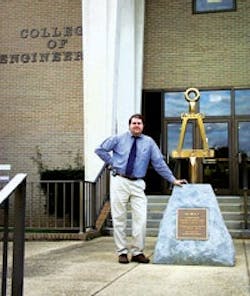Small Infrastructure, Big Results
About the author: Darren Paschke is systems asset manager for Orenco Systems Inc. Paschke can be reached at [email protected] or 800.348.9843.
Since the 1950s, South Alabama Utilities (SAU), a utility serving the rural areas of Mobile County, has been providing water service to 13,000 customers and gas service to 6,000 customers. By the late 1990s, new development and potential new customers were headed their way.
“To compete for new development opportunities, we felt it was essential to make sewers available,” said Donnie Cunningham, SAU executive director. “In the areas we serve, utilities don’t have exclusive territories. We were on the verge of losing potential new customers we felt should have been ours.”
To serve the subdivisions springing up throughout western Mobile County, SAU was encouraged to break into the wastewater business by a local developer, Steve Brewer. Brewer, a partner with his son at Brewer Homes, was having a difficult time locating land where he could install conventional septic systems, and sought alternatives. Brewer’s search led him to Kevin White, Ph.D., P.E., a professor and chair of civil engineering at the University of South Alabama, who advocates utility-managed decentralized wastewater treatment (DWWT), including effluent sewers.
Before entering into the DWWT business, SAU did its homework and sent a board member and two consulting engineers from Speaks & Associates to visit Orenco Systems, manufacturers of effluent sewer equipment. During the visit, they toured nearby effluent sewer communities.
“I was impressed with the longevity of the systems and how little maintenance they required,” said Mikell Speaks, a consulting engineer with Speaks & Associates. “I spoke with one technician who said he felt like the Maytag repairman; he received maybe two calls a year.”
Since 2002, SAU and local developers have installed 67 miles of interconnected effluent sewers, along with 150 AdvanTex textile filters in 14 different treatment plants. SAU has become a national model for utility-managed effluent-only sewers and DWWT. Its network of effluent sewers and treatment plants are all interconnected, so flows can be sent “down the line” for treatment whenever needed. This has the effect of expanding system capacity at low cost and providing redundancy in emergencies.
The sewer line now serves 47 subdivisions and commercial properties. At full build-out, the system will have the capacity to serve nearly 4,000 new homes, schools, apartments and business parks. To SAU, this means 4,000 new customers and an additional $140,000 per month in service charges.
DWWT in Action
Effluent sewer systems include equipment on each lot (a tank to retain solids, a pump package and a control panel), followed by small-diameter effluent collection lines that transport filtered effluent to a DWWT system—typically low-maintenance textile filters—and then to a subsurface dispersal system.
To ensure product consistency, SAU purchased all collection and treatment equipment from Orenco’s local distributor and AdvanTex dealer, William McLean of Dauphin Environmental Equipment LLC.
Under SAU’s program, all parties—developers, property owners and the utility—share the cost of extending wastewater infrastructureon a “build-as-you-go” basis. White estimated the total cost for systems such as SAU’s at approximately $11,000 per lot, including both collection and treatment.
“The whole system is modular, so most costs are only incurred as needed,” Cunningham said. “The treatment and dispersal systems can be built in phases. Monthly service charges from phase-one homeowners help build a reserve for development of the next phase.”
From the Field
“We get nothing but positive reactions from our homebuyers,” Brewer said. “As far as they’re concerned, they have a centralized sewer system. If they have a problem, they pick up the phone and call SAU.”
On the commercial side, SAU is now providing wastewater treatment for a 172-unit apartment complex, a 31-lot business park and numerous other commercial properties.
Effluent sewer systems like SAU’s require little maintenance. SAU, for example, estimates that a two-person crew can install on-lot equipment at a home in half a day and a single person can perform maintenance on the equipment in an hour. At the treatment plants, a two-person crew can perform routine maintenance on three 30,000-gal-per-day plants in a single day, and spend as little as an hour at each, checking pumps and cleaning filters.
“We’ve become more proactive with treatment plant maintenance,” said Tim Lee, lead field operator. “We test the effluent biweekly at all plants and then ‘spreadsheet’ the results. If we come across abnormal samples, we perform maintenance.”
Sampling data shows SAU’s treatment systems produce effluent that consistently falls within permit limits.
A National Model
In the Mobile area, seven different utilities and small towns in four different counties now are using Orenco effluent sewers and AdvanTex treatment systems. They are toured by out-of-area groups and have become the subject of classes, workshops, seminars and articles.
These systems represent a significant performance improvement over traditional septic tank and drainfield developments of the past, according to the U.S. Environmental Protection Agency, by providing a savings of 25% to 50% over centralized collection and treatment.
In 2010, the Water Environment Research Foundation published a series of fact sheets displaying costs for several sewer technologies. Based on costs for a 200-home system, the fact sheets showed that effluent sewers are one-third less costly than gravity sewers, and the cost of treatment is significantly lower, too.
“Effluent sewers and attached-growth treatment systems minimize solids handling, thus allowing for smaller infrastructure and lower costs,” White said. “If we had to do it over again, knowing what we know now about the huge costs and environmental issues with centralized city sewers, we might not have done it in that way. Certainly, in many outlying areas, decentralized wastewater concepts would dominate.”
